What is a Queue Management System? A guide for UK Businesses
Skip the Blog and go straight to the Super Low-Cost Queue Management ->
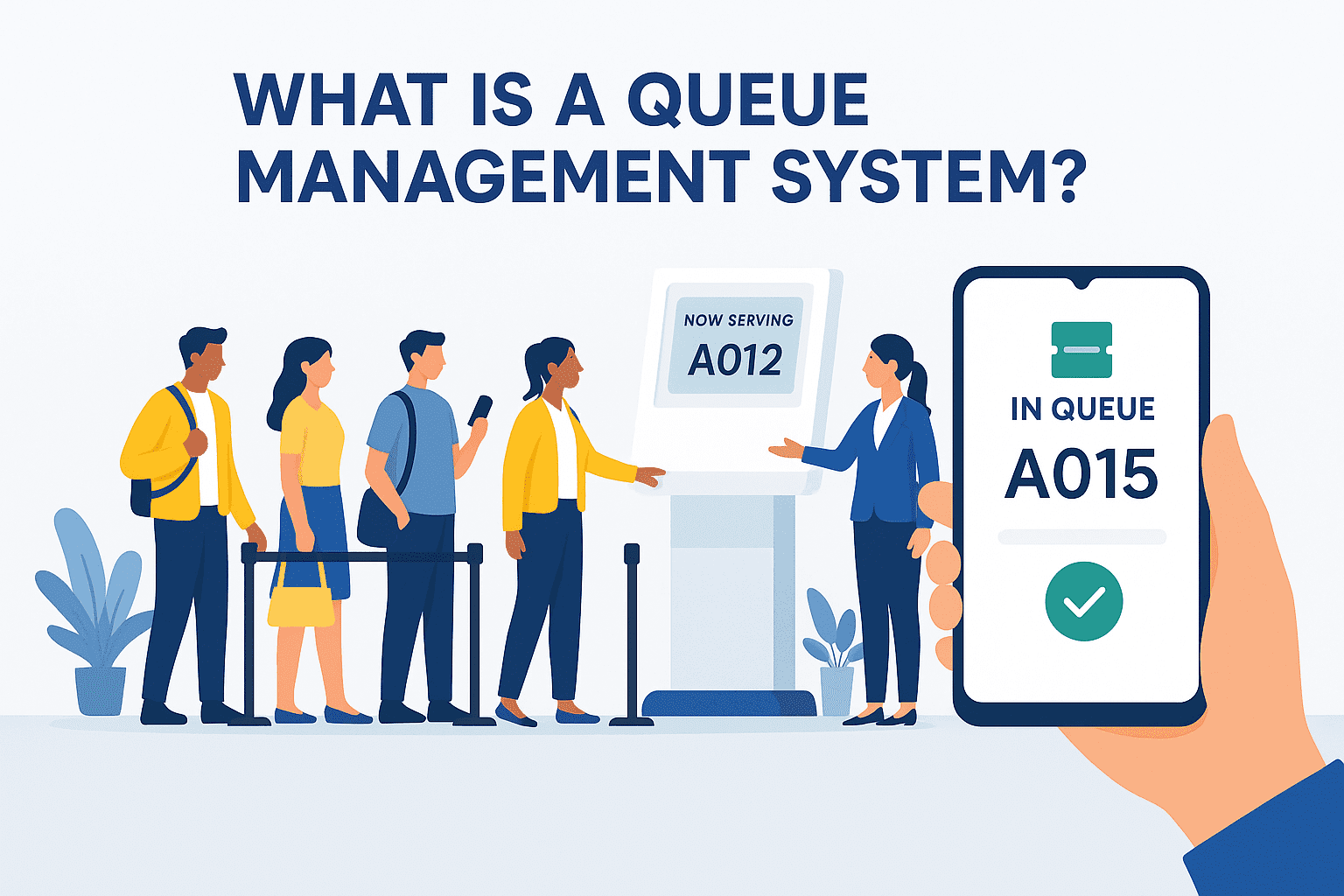
What Is a Queue Management System? – Smart Customer Flow with QueueAwayWhat Is a Queue Management System?
In the UK, where queues are a cultural norm but increasingly a source of frustration, businesses across healthcare, retail, education and the public sector are rethinking how they manage customer flow. Long waits in GP surgeries, crowded high street branches, and inefficient government service counters are more than just inconvenient — they harm customer experience and staff productivity.
A Queue Management System (QMS) offers a solution tailored to the needs of British organisations. This guide explores how QMS works, its relevance to UK-specific challenges, and how platforms like QueueAway help improve service delivery, customer satisfaction, and compliance with industry standards.
According to results from QueueAway implementations, UK businesses have seen up to 45% reductions in customer wait times and 22% higher satisfaction scores—proving the tangible benefits of effective queue management.
A Queue Management System Explained
A queue management system (QMS) is a powerful tool designed to streamline service delivery and reduce waiting times for customers. Whether you're looking for the best queue management system in the UK or exploring virtual queue software for, barbershops, restaurants or even GP surgeries, modern solutions like QueueAway offer scalable and efficient ways to manage footfall and appointments.
Systems like QueueAway remove the need for physical waiting rooms, prevent bottlenecks, and make the customer journey more efficient and predictable.
Looking for the Best Queue Management System in the UK?
When it comes to selecting the best queue management system in the UK, factors such as flexibility, virtual queuing, mobile access, and data insights are key. QueueAway is designed with UK businesses in mind—supporting industries from NHS clinics to council offices and high-street retailers.
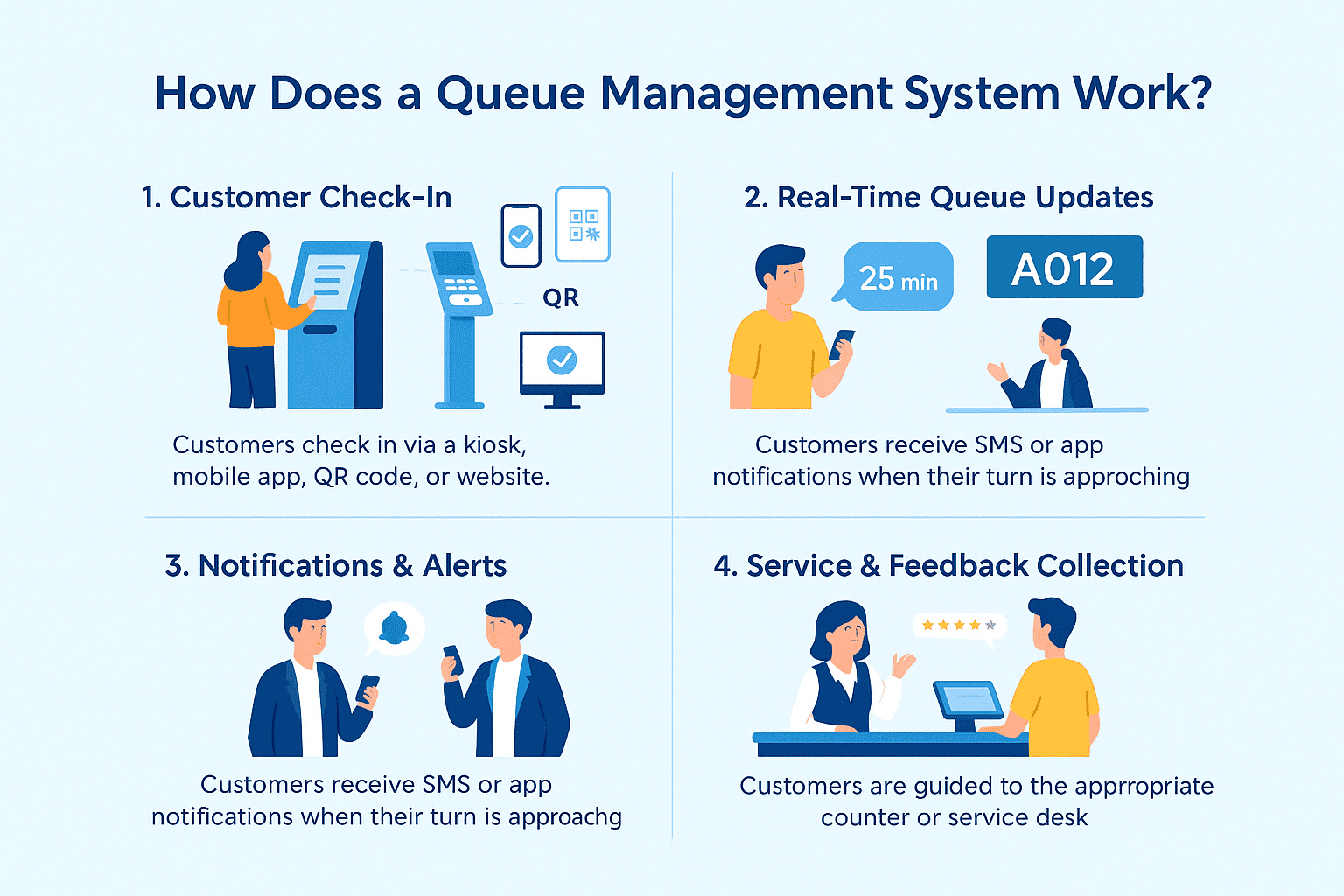
How a Queue Management System Works – Step-by-Step Infographic by QueueAwayHow a queue management system works—from check-in and queue updates to notifications and service feedback—offering a clear look at its impact on customer flow and satisfaction.How Does a Queue Management System Work?
Customer Check-In: Visitors check in via app, QR code, or self-service kiosk.
Queue Assignment: The system categorizes them based on service type, urgency, or booking.
Real-Time Updates: Customers receive updates and estimated wait times on their device.
Service Notification: When it's their turn, customers are notified via text or app.
Post-Service Feedback: Optional customer feedback can be collected immediately.
This simple but powerful flow creates a frictionless customer journey and optimizes resource allocation for staff.
In real-world deployments, QueueAway's virtual queue system has helped GP surgeries reduce walk-in congestion by 60% during peak morning hours by allowing patients to join the queue remotely and receive real-time updates.
Why It Matters in the UK
According to Citizens Advice, more than 6 million UK consumers experienced delays or difficulties accessing public services in 2023. From NHS walk-in centres to DVLA branches and local councils, long queues remain a pain point.
UK shoppers and service users expect smoother experiences, especially post-COVID-19. With hybrid working on the rise, customers value services that respect their time, offer flexibility, and reduce unnecessary in-person contact.
A QMS not only aligns with British service expectations — it also helps meet standards around accessibility, GDPR, and operational efficiency.
What Are the Three 3 Types of Queueing Systems?
Queue management systems can generally be classified into three main types based on how customers are served and managed, the basics are as follows, but to learn more check out our blog What are the three 3 types of queueing systems?
1. Linear Queues
This is the traditional first-come, first-served (FCFS) system where customers stand in a single line and are served sequentially. Examples include grocery store checkout lines and bank teller queues.
2. Virtual Queues
In virtual queue systems, customers check in remotely via mobile apps or kiosks and receive updates about their waiting time without having to stand in a physical line. This is commonly used in healthcare, retail, and customer service industries. Many queue management system solutions now offer virtual queueing to help customers wait from anywhere using mobile apps. Explore how the Virtual Queue App by QueueAway enhances convenience and flexibility for both customers and staff.
3. Priority Queues
Some businesses implement priority queueing, where certain customers (such as VIPs, members, or urgent cases) are given preference over others. This is often used in emergency rooms, banking services, and customer loyalty programs.

Types of Queueing Systems – Linear, Virtual, and Priority Explained by QueueAway
The three main types of queueing systems—linear queues, virtual queues, and priority queues—highlighting how each operates in various business environments.
Benefits of a Queue Management System
Implementing a queue management system offers measurable improvements across multiple metrics:
Reduced Wait Times: Customers spend less time physically waiting.
Improved Customer Experience: No standing in lines means higher satisfaction.
Operational Efficiency: Staff manage customer flow more effectively.
Data-Driven Decisions: Real-time dashboards enable smart scheduling and planning.
Accessibility: Virtual systems offer better access for people with mobility issues.
According to industry reports, businesses using a queue management system see up to a 35% reduction in perceived wait times and a 25% increase in satisfaction scores.
Reduced wait times: Pharmacies using QueueAway saw wait times drop from 18 minutes to under 10 minutes.
Improved customer feedback: Retailers using our feedback tool saw a 22% increase in CSAT scores.
Lower no-show rates: Locations that enabled SMS alerts reported 35% fewer missed appointments.
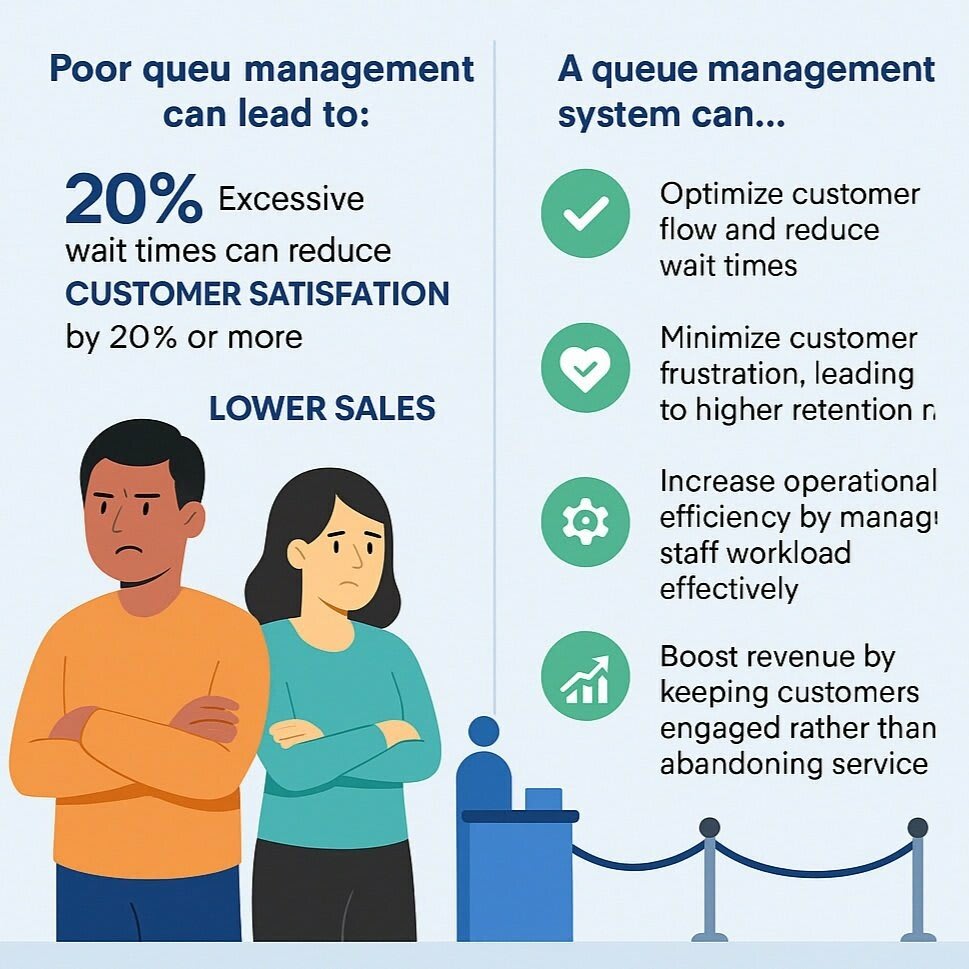
The Importance of Queue Management in Business – Full Visual by QueueAwayContrasts of the negative impacts of poor queueing with the operational and financial benefits of queue management system software, emphasizing the value QueueAway brings to customer service.Key Benefits of a Queue Management System
1. Reduces Customer Wait Times by Up to 50%
Studies show that businesses using a queue management system can cut wait times by 50% or more.
Virtual queueing allows customers to spend their waiting time productively rather than standing in line.
2. Increases Customer Satisfaction by Over 30%
73% of customers say long queues are one of the most frustrating parts of shopping or visiting service centers. (Source: Retail Customer Experience Report)
A well-structured queue system ensures smoother service flow and higher customer retention.
3. Boosts Sales & Revenue
Retailers using queue management software experience an average 20-30% increase in sales because customers continue shopping while they wait. (Source: Business Insider)
Restaurants and service providers see improved booking efficiency, increasing table turnover rates.
4. Enhances Employee Productivity
20% of employee productivity is lost when they have to manually manage long queues. (Harvard Business Review)
Automating queue management allows staff to focus on customer service rather than handling crowds.
5. Reduces Walkaways & Abandoned Transactions
Studies reveal that 40% of customers leave without purchasing or completing service due to long lines.
A queue management system keeps customers engaged and reduces abandonment rates.
6. Provides Real-Time Data & Insights
Queue management system software tracks key metrics such as:
Average wait times
Customer flow trends
Service performance
This data allows businesses to adjust staffing levels, predict peak hours, and improve service strategies.
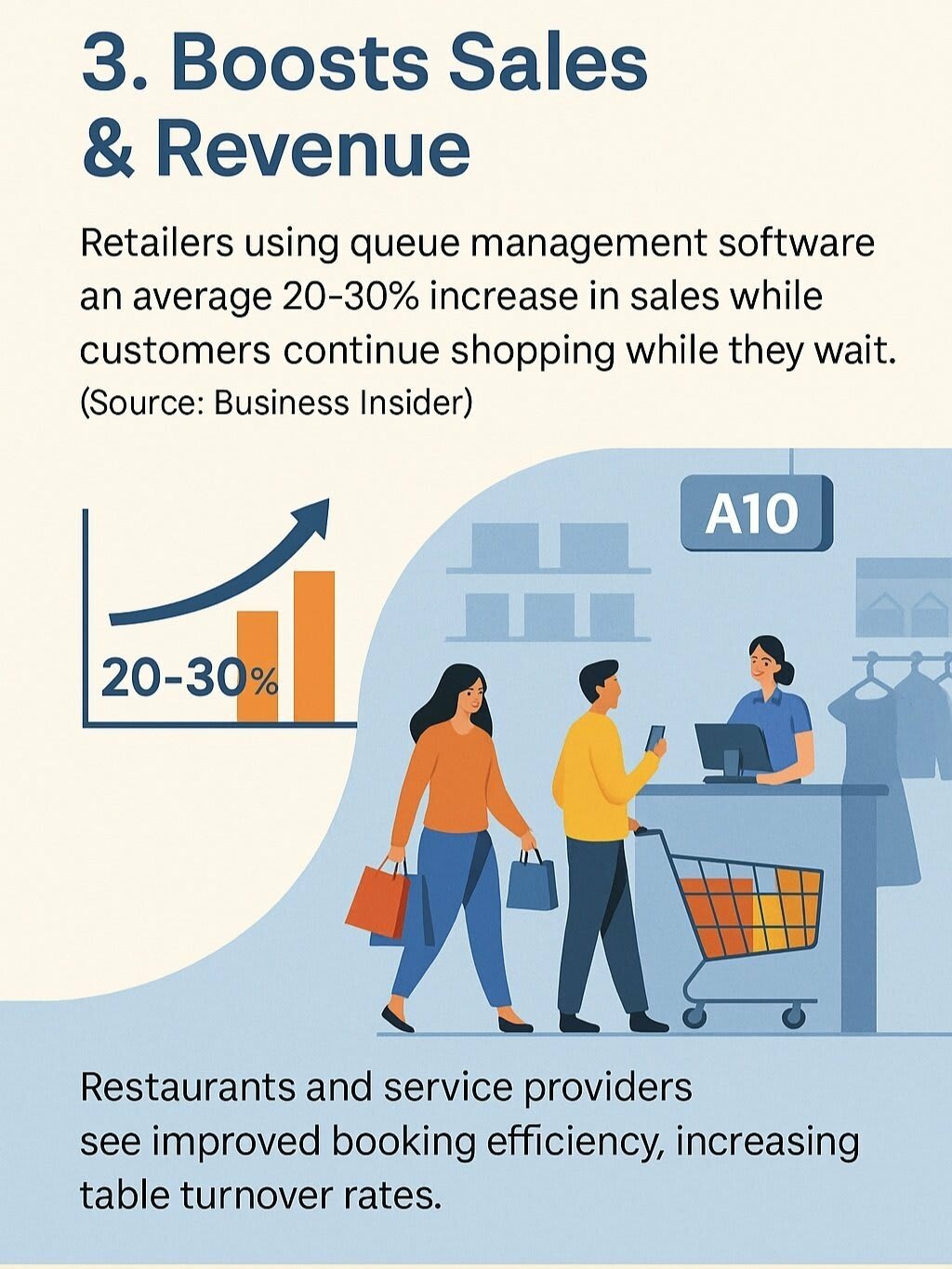
The Importance of Queue Management in Business – Full Visual by QueueAwayThe negative impacts of poor queueing with the operational and financial benefits of queue management system software, emphasizing the value QueueAway brings to customer service7. Enables Contactless & Socially Distanced Waiting
Since the COVID-19 pandemic, many businesses have adopted virtual queueing to maintain safety and hygiene standards.
Customers can wait from a safe location and receive notifications when their turn arrives.
Organisations across industries are adopting queue management system tools not only for convenience, but because they deliver measurable improvements in operational flow. According to the Gartner IT Glossary, queue management is a critical component of customer experience strategy, especially in high-traffic service environments.
Where UK Organisations Benefit Most
NHS & Private Healthcare
Hospitals, GP surgeries and private clinics use QMS to avoid full waiting rooms, protect patient privacy, and manage appointment overruns more smoothly.
Retail & High Street Services
Banks, mobile shops, and high-street retailers use QMS to reduce walkout rates and improve queue transparency during peak hours.
Government & Local Councils
Council offices, passport offices, and DVLA branches reduce service congestion and improve accessibility by adopting QMS solutions.
Education
Universities and colleges can simplify student services, from admissions to bursary support, by digitising the queueing process.
Transport Hubs
Train stations and ferry terminals use QMS to guide passengers and manage crowd flow — especially during strikes or peak travel seasons.
Key Benefits for UK Businesses
Shorter Queues: Improve flow and reduce customer drop-off.
Better Compliance: Align with GDPR, accessibility, and data standards.
Staff Efficiency: Less time spent managing crowds.
Remote Queueing: Customers wait where they’re comfortable.
Increased Satisfaction: Transparent service makes happier customers.
Key Features to Look for in a Queue Management System
When selecting a queue management system, consider the following features:
Multi-Channel Check-In:
Options for customers to join queues via kiosks, mobile apps, or online portals.Wikipedia
Real-Time Monitoring:
Tools to track queue statuses and service times, allowing for prompt adjustments.
Customizable Notifications:
Automated alerts for customers and staff regarding queue progress and service updates.
Data Analytics and Reporting:
Comprehensive insights into customer behavior and operational efficiency.
Integration Capabilities:
Ability to integrate with existing systems such as CRM or POS for a seamless operation.
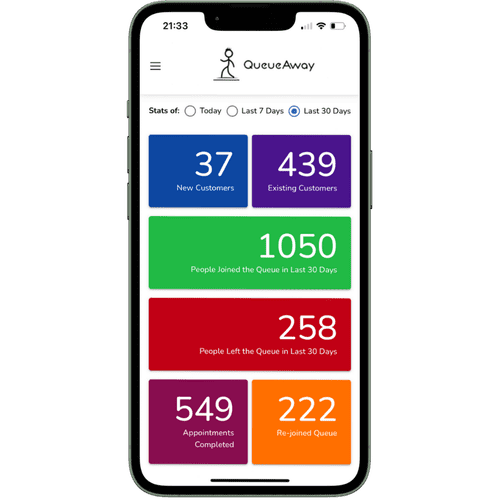
QueueAway collects and presents comprehensive data related to your queue line performance from your queue management system, effectively helping you to highlight key insights into your queue dynamics. This invaluable information allows you to make informed, data-driven decisions that directly impact the efficiency and success of your business. Whether you are a small local establishment or a large enterprise, every decision you make matters significantly, and harnessing this data can lead to improvements that benefit organisations of all sizes.
Industries That could Benefit Most
Queue management systems aren’t one-size-fits-all; they adapt to the needs of various industries:
Healthcare: Manage appointments, walk-ins, and emergencies more efficiently.
Key Stat:
In a single month (Nov 2023), over 1.5 million GP appointments in England were scheduled 4+ weeks in advance.
Source: NHS Digital
Use for QueueAway: Long lead times reflect poor in-practice capacity planning. QueueAway helps optimize arrival timing and patient flow.
“By introducing virtual queue notifications, surgeries can reduce on-site waiting, allowing GPs to triage more effectively.”
Retail: Prevent overcrowding and offer a seamless shopping experience.
Key Stat:
UK retail footfall dropped 2.2% in December 2024, and high queueing times remain a leading cause of abandoned in-store purchases.
Source: British Retail Consortium
Use for QueueAway: Use queue management to increase conversions and customer retention in-store.
“Virtual queueing reduces abandonment and boosts in-store conversion rates—especially during peak hours and sales periods.”
Government Services: Simplify check-ins for passport, licensing, and permit offices.
Key Stat:
Councils like Manchester, Birmingham, and Lambeth have moved toward digital appointment systems to handle demand in housing, licensing, and benefits offices.
Use for QueueAway: Local authorities are actively seeking ways to digitize queuing and service triage.
“QueueAway empowers councils to improve efficiency in high-demand departments like housing and planning, cutting down on physical queues and admin strain.”
Banking: Organize teller lines and private consultation queues.
Key Stat:
The number of UK bank branches dropped from over 10,500 in 2014 to fewer than 6,900 by 2024, limiting in-person service options. At the same time, major UK banks suffered digital outages in early 2025, leaving customers unable to access online banking.
Source: The Guardian, February 2025
Use for QueueAway:
With fewer physical locations and unreliable digital alternatives, banks must maximize efficiency and experience in-branch. QueueAway enables branch-level queue management, appointment scheduling, and check-in solutions.
“QueueAway ensures that limited physical banking resources are optimized, reducing in-branch wait times and boosting service satisfaction.”
Education: Streamline administrative and student services.
Hospitality: From hotel check-ins to spa bookings, improve every guest’s journey.
Key Stat:
53% of UK hospitality managers reported staffing shortages that impact customer service. Meanwhile, demand surges during events and holidays frequently overwhelm on-site teams.
Source: Axonify UK Hospitality Workforce Survey 2024
Use for QueueAway:
QueueAway offers real-time virtual queueing and mobile check-in tools, helping venues reduce walkaways and better manage fluctuating volumes without extra staffing.
“With QueueAway, hospitality venues can keep guests informed and engaged—even when short-staffed—resulting in faster service and higher satisfaction.”
Physical vs. Virtual Queue Management Systems
Feature
Physical Queue Management System
Virtual Queue Management System
Check-In Method
Kiosk or Receptionist
Mobile App or Web
Infrastructure Needed
Customer Convenience
Scalability
Cost
High
Moderate
Limited
Higher upfront cost
Low
High
Highly Scalable
Lower ongoing cost
QueueAway’s virtual-first platform provides all the benefits of traditional queue management while enhancing flexibility, customer satisfaction, and ROI.
Implementing QueueAway in Your Business
QueueAway offers a comprehensive queue management system tailored to meet the unique needs of various industries. By integrating QueueAway into your operations, you can expect:
Seamless Customer Check-In:
Multiple channels for customers to join queues, enhancing convenience.
Efficient Queue Management:
Real-time updates and notifications to keep customers informed and reduce no-shows.
Actionable Insights:
Detailed analytics to help you understand customer behavior and optimize service delivery.
Implementing QueueAway can transform your customer service experience, leading to increased satisfaction and loyalty.
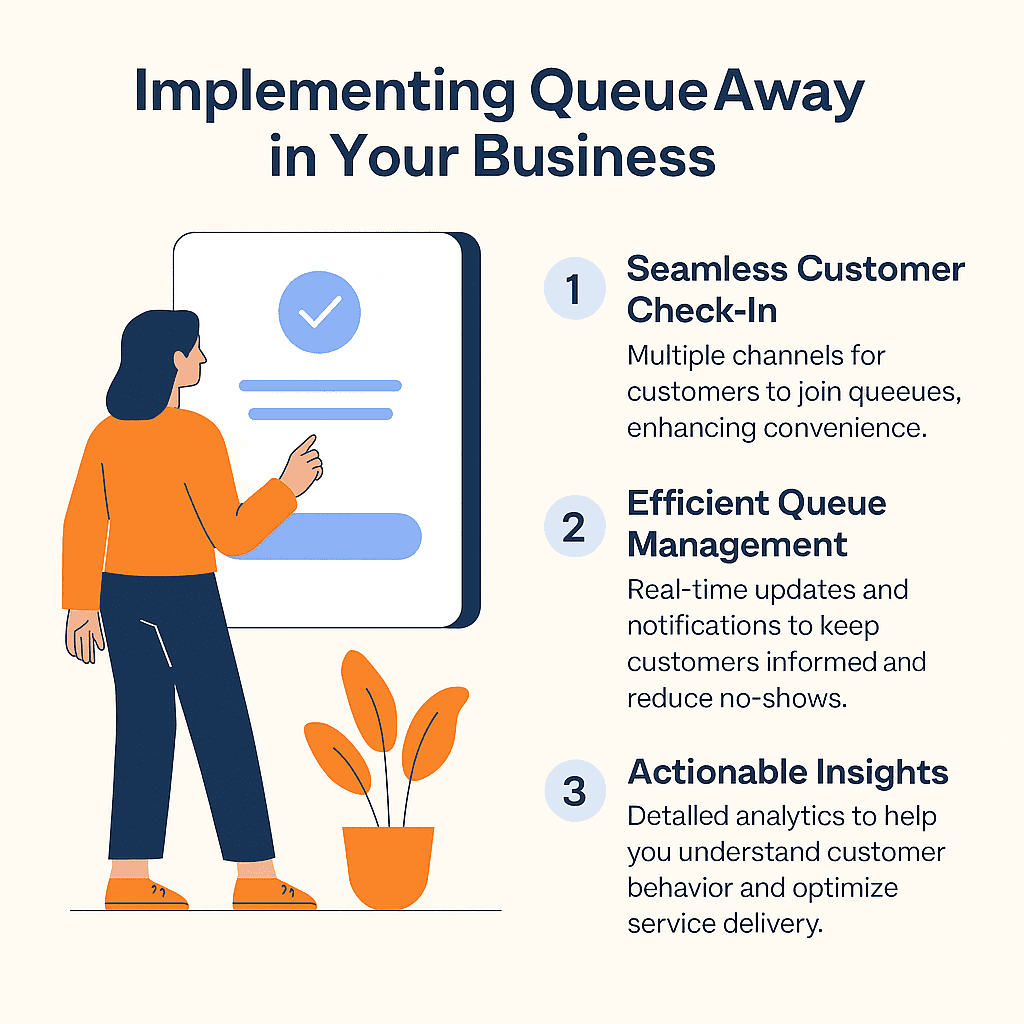
Implementing QueueAway in Your Business – Queue Management System Software BenefitsHow businesses benefit from implementing QueueAway’s queue management system software, showcasing features like seamless check-ins, efficient queue handling, and actionable analytics.QueueAway: The Best Queue Management System for Your Business
Looking for a smart, efficient, and easy-to-use queue management system?
QueueAway offers a powerful virtual queue solution designed to enhance customer experience and optimize business efficiency.
Why Choose QueueAway?
QueueAway is designed for UK-based businesses that need an intuitive, affordable, and compliant queue management solution.
What Sets It Apart:
No hardware required — works with smartphones and browsers
Full GDPR compliance
Mobile-first, easy setup in under a day
Insights by location, service type, and time of day
Custom branding for consistency with UK retail and healthcare brands
From helping pharmacies comply with NHS queue standards to easing the flow at university student centres, QueueAway makes queueing smarter — and British service delivery better.
Why Choose QueueAway in the UK?
At QueueAway, we understand the unique needs of UK businesses and public services—from GP surgeries and high street retailers to Post Offices, councils, and banks. That’s why our queue management system is built with full GDPR compliance, UK-specific integrations, and customer support based right here in the UK.
Whether you're serving customers in London, Liverpool, or Leeds, QueueAway ensures your operation runs smoothly, queues move faster, and your team spends less time managing footfall and more time delivering great service.
UK-based support
Fully GDPR-compliant
Tailored for British businesses and public sector workflows
Ready to transform your queuing experience?
Book a free demo or contact our UK support team today and see how QueueAway can streamline your customer flow.
Conclusion: Why Every Business Needs a Queue Management System
British consumers are polite — but they don’t enjoy waiting. In a market where loyalty hinges on experience, digital queue management is becoming a competitive necessity.
Whether you’re a GP, a retailer, or a council office, QueueAway gives you the tools to modernise customer service while improving efficiency and compliance.
With QueueAway, British businesses can take control of their queues, optimize their operations, and ensure a seamless customer journey.
🚀 Ready to revolutionize your queue management? Visit QueueAway today and transform the way you handle queues!
Get Started with QueueAway Today
Whether you’re in healthcare, retail, finance, or government services, QueueAway delivers the tools to manage customer flow with precision.
Book a free demo and discover how our queue management system can transform your business today.
Related Links:
Queue Management System for Retail
Virtual Queue App
Contact Us
Looking for the U.S. version? Read our comprehensive guide for American businesses →
Frequently Asked Questions
Q1: What is a queue management system (QMS)?
QueueAway’s queue management system (QMS) is a technology-driven solution designed to organize queues, manage appointments, and enhance the overall customer experience. It automates customer flow by structuring queues efficiently, allowing businesses to handle service delivery more effectively.
Q2: How does a queue management system work?
A queue management system typically operates through the following steps:
Customer Check-In: Customers check in via a kiosk, mobile app, QR code, or website.
Real-Time Queue Updates: Customers receive an estimated wait time and can track their position in the queue.
Notifications & Alerts: Customers receive SMS or app notifications when their turn is approaching.
Service & Feedback Collection: Customers are guided to the appropriate counter or service desk, and after receiving service, they can provide feedback for quality improvement.
Q3: What are the benefits of implementing a queue management system?
Implementing a queue management system offers several advantages:
Enhanced Customer Experience: By eliminating physical queues, customers can wait comfortably and receive timely updates.
Improved Operational Efficiency: Businesses can manage customer flow more effectively, reducing wait times and optimizing staff allocation.
Data Collection & Analysis: queue management system provides valuable insights into customer behavior and service performance, aiding in continuous improvement.
Q4: In which industries is a queue management system applicable?
Queue management systems are versatile and can be applied across various sectors, including:
Healthcare: Managing patient appointments and walk-ins.
Retail: Streamlining checkout processes and customer service desks.
Hospitality: Handling reservations and guest services.
Government Services: Organizing citizen services and reducing wait times.
Q5: How does QueueAway enhance queue management?
QueueAway offers a comprehensive queue management system that allows customers to join queues remotely, receive real-time updates, and provide feedback post-service. It integrates seamlessly with existing systems and is suitable for various industries, enhancing both customer satisfaction and operational efficiency.
Q: What kind of results can I expect from a queue management system like QueueAway?
A: Businesses across sectors have reported major improvements. For example, a UK council using QueueAway increased appointment throughput by 25%, while a pharmacy group cut average wait times nearly in half.


